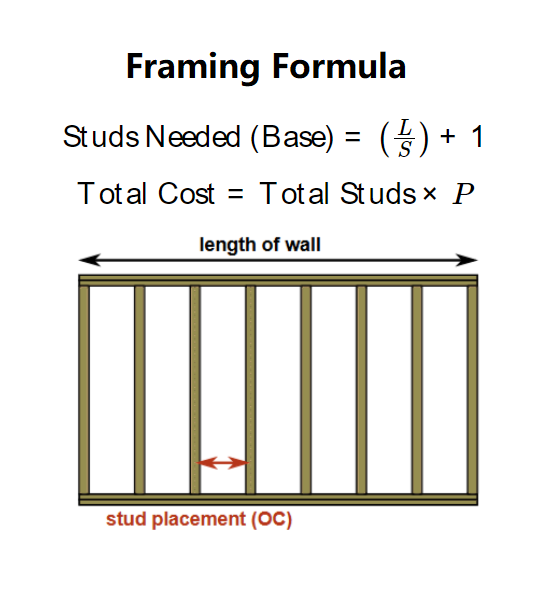1. What is Framing Calculator?
Definition: This calculator determines the number of studs needed for a wall frame and the total cost based on the wall length, OC (on-center) spacing, price per stud, and estimated waste percentage.
Purpose: It is used in construction and carpentry to plan wall framing for buildings, ensuring accurate material estimation and cost calculation for framing projects.
2. How Does the Calculator Work?
The calculator uses the following equations:
- \( \text{Studs Needed (Base)} = \left(\frac{L}{S}\right) + 1 \)
- \( \text{Total Studs} = \lceil \text{Studs Needed (Base)} \times (1 + \text{Waste Percentage}) \rceil \)
- \( \text{Total Cost} = \text{Total Studs} \times P \)
Where:
- \( L \): Wall length (in, converted from selected unit);
- \( S \): OC spacing (in, converted from selected unit);
- \( P \): Price per stud ($);
- \( \text{Waste Percentage} \): Estimated waste percentage (default 15%).
Steps:
- Enter the wall length (\( L \)) with its unit.
- Enter the OC spacing (\( S \)) with its unit.
- Enter the price per stud (\( P \)) (default 0).
- Enter the estimated waste percentage (default 15%).
- Convert \( L \) and \( S \) to inches.
- Calculate the base number of studs: \( \left(\frac{L}{S}\right) + 1 \).
- Adjust for waste: \( \lceil \text{Base Studs} \times (1 + \text{Waste Percentage}) \rceil \).
- Calculate the total cost: \( \text{Total Studs} \times P \).
- Display the results: total studs needed and total cost.
3. Importance of Framing Calculation
Calculating framing requirements is crucial for:
- Material Estimation: Determining the exact number of studs to avoid over- or under-purchasing.
- Cost Planning: Estimating the total cost of the framing project to stay within budget.
- Structural Integrity: Ensuring the wall frame meets building codes and provides adequate support.
4. Using the Calculator
Example 1 (Same Units, No Cost): Calculate the studs needed for a wall:
- Wall Length: \( L = 16 \, \text{ft} \);
- Convert \( L \): \( L = 16 \times 12 = 192 \, \text{in} \);
- OC Spacing: \( S = 16 \, \text{in} \);
- Base Studs: \( \left(\frac{192}{16}\right) + 1 = 12 + 1 = 13 \);
- Waste Percentage: 15%;
- Total Studs: \( \lceil 13 \times (1 + 0.15) \rceil = \lceil 14.95 \rceil = 15 \);
- Price per Stud: \( P = 0 \, \$ \);
- Total Cost: \( 15 \times 0 = 0 \, \$ \);
- Result: \( 15 \, \text{studs} \), Total Cost: \( 0.00 \, \$ \).
Example 2 (Mixed Units, With Cost): Calculate the studs needed for a wall:
- Wall Length: \( L = 5 \, \text{m} \);
- Convert \( L \): \( L = 5 \times 39.3701 = 196.8505 \, \text{in} \);
- OC Spacing: \( S = 0.4 \, \text{m} \);
- Convert \( S \): \( S = 0.4 \times 39.3701 = 15.74804 \, \text{in} \);
- Base Studs: \( \left(\frac{196.8505}{15.74804}\right) + 1 = 12.5 + 1 = 13.5 \);
- Waste Percentage: 10%;
- Total Studs: \( \lceil 13.5 \times (1 + 0.1) \rceil = \lceil 14.85 \rceil = 15 \);
- Price per Stud: \( P = 2.5 \, \$ \);
- Total Cost: \( 15 \times 2.5 = 37.5 \, \$ \);
- Result: \( 15 \, \text{studs} \), Total Cost: \( 37.50 \, \$ \).
5. Frequently Asked Questions (FAQ)
Q: Why do we add one stud to the calculation?
A: The base formula calculates the studs between the ends of the wall plus one end stud. Adding one more stud ensures both ends of the wall are accounted for in the frame.
Q: What is OC spacing?
A: OC (on-center) spacing is the distance between the center of one stud to the center of the next stud, typically 16 or 24 inches in standard construction.
Q: Why include a waste percentage?
A: The waste percentage accounts for cutting losses, defects, or errors during installation, ensuring you have enough studs to complete the project.
 Home
Home
 Back
Back
